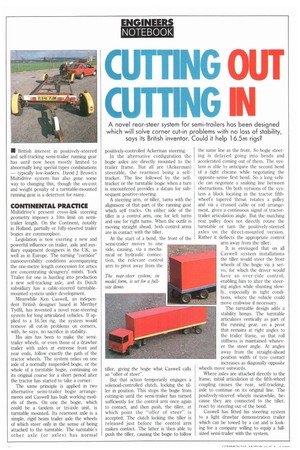CUTTING OUT CUTTING IN
Page 42

If you've noticed an error in this article please click here to report it so we can fix it.
A novel rear-steer system for semi-trailers has been designed which will solve corner cut-in problems with no loss of stability, says its British inventor. Could it help 16.5m rigs?
IN British interest in positively-steered and self-tracking semi-trailer running gear has until now been mostly limited to abnormally long special types combinations — typically low-loaders. David J Brown's Multidrive system has also gone some way to changing this, though the on-cost and weight penalty of a turntable-mounted running gear is a deterrent for many.
CONTINENTAL PRACTICE
Multidrive's present cross-link steering geometry imposes a 10m limit on semitrailer length. On the Continent, notably in Holland, partially or fully-steered trailer bogies are commonplace.
Legislation is now exerting a new and powerful influence on trailer, axle and auxiliary equipment designers in the UK, as well as in Europe. The turning ''corridor" manoeuvrability conditions accompanying the one-metre length concession for artics are concentrating designers' minds. York Trailer for one is hustling into production a new self-tracking axle, and its Dutch subsidiary has a cable-steered turntablemounted system under development.
Meanwhile Ken Caswell, an independent British designer based in Merthyr Tydfil, has invented a novel rear-steering system for long articulated vehicles. If applied to a 16.5m rig, the system would remove all cut-in problems on corners, with, he says, no sacrifice in stability.
His aim has been to make the semitrailer wheels, or even those of a drawbar trailer with axles at extreme front and rear ends, follow exactly the path of the tractor wheels. The system relies on one axle of a normally suspended bogie, or the whole of a turntable bogie, continuing on its original course for a short period after the tractor has started to take a corner.
The same principle is applied in two alternative semi-trailer bogie arrangements and Caswell has built working models of them. On one the bogie, which could be a tandem or tri-axle unit, is turntable mounted. Its rearmost axle is a simple, rigid beam trailer axle the wheels of which steer only in the sense of being attached to the turntable. The turntable's other axle (or axles) has normal positively-controlled Ackerman steering.
In the alternative configuration the bogie axles are directly mounted to the trailer frame. But all are (Ackerman) steerabie, the rearmost being a selftracker. The line followed by the selftracker or the turntable bogie when a turn is encountered provides a datum for subsequent positive-steering.
A steering arm, or tiller, turns with the alignment of that part of the running gear which self tracks. On either side of the tiller is a control arm, one for left turns and one for right turns. When the outfit is moving straight ahead, both control arms are in contact with the tiller.
At the start of a bend, the front of the semi-trailer moves to one side, causing, via a mechanical or hydraulic connection, the relevant control arm to pivot away from the tiller, giving the bogie what Caswell calls an "offer of steer".
But that action temporarily engages a solenoid-controlled clutch, locking the tiller in position. This stops the bogie from cutting-in until the semi-trailer has turned sufficiently for the control arm once again to contact, and then push, the tiller, at which point the "offer of steer" is accepted. The clutch locking the tiller is released just before the control arm makes contact. The latter is then able to push the tiller, causing the bogie to follow
the same line as the front. So bogie steering is delayed going into bends and accelerated coming out of them. The system is able to anticipate the second bend of a tight chicane while negotiating the opposite-sense first bend. So a long vehicle can negotiate a snaking line between obstructions. On both versions of the system a block locating in the tractor fifthwheel's tapered throat rotates a pulley and via a crossed cable or rod arrangement, gives a continuous signal of tractortrailer articulation angle. But the matching rear pulley does not directly rotate the turntable or turn the positively-steered axles on the direct-mounted version. Rather it deflects the appropriate control arm away from the tiller.
It is envisaged that on all Caswell system installations the tiller would steer the front wheels of the bogie via a servo, for which the driver would have an over-ride control, enabling him to alter the steering angles while shunting slowly, especially in tight conditions, where the vehicle could move crabwise if necessary.
The turntable design adds a stability bonus. The turntable articulates vertically as part of the running gear, on a pivot that remains at right angles to the trailer frame, so that roll stiffness is maintained whatever the steer angle. At angles away from the straight-ahead position width of tyre contact increases as diagonally opposite wheels move outwards.
Where axles are attached directly to the frame, initial articulation at the fifth-wheel coupling causes the rear, self-tracking, axle to continue on its original line. The positively-steered wheels meanwhile, because they are connected to the tiller, react by steering out of the bend.
Caswell has fitted his steering system to a light drawbar demonstration trailer which can be towed by a car and is looking for a company willing to equip a fullsized semi-trailer with the system.








































































































































